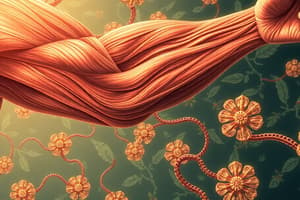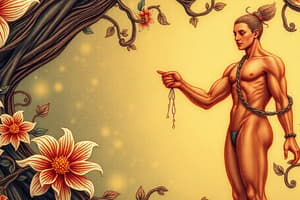Podcast
Questions and Answers
What effect does the binding of calcium ions to the troponin complex have on the actin filament?
What effect does the binding of calcium ions to the troponin complex have on the actin filament?
- It causes actin filaments to contract independently.
- It cleaves ATP to enhance energy efficiency.
- It uncovers the active sites on the actin filament. (correct)
- It prevents myosin heads from attaching to actin.
What happens to ATP during the contraction process?
What happens to ATP during the contraction process?
- It is cleaved to form ADP and phosphate ion. (correct)
- It is utilized without any breakdown.
- It undergoes complete hydrolysis to form glucose.
- It is generated from ADP during contraction.
Which statement best describes the Fenn effect?
Which statement best describes the Fenn effect?
- Calcium ions reduce the affinity of troponin for actin.
- Increased muscle workload leads to decreased ATP cleavage.
- More work performed by the muscle correlates with more ATP being cleaved. (correct)
- Muscle contraction results in the formation of lactic acid.
What is the role of the myosin head in muscle contraction?
What is the role of the myosin head in muscle contraction?
What must happen before contraction begins in muscle fibers?
What must happen before contraction begins in muscle fibers?
During muscle contraction, what is the conformational change that occurs in the myosin head?
During muscle contraction, what is the conformational change that occurs in the myosin head?
What role does the troponin-tropomyosin complex play during muscle contraction?
What role does the troponin-tropomyosin complex play during muscle contraction?
What is the final result of the interaction between myosin heads and actin filaments during contraction?
What is the final result of the interaction between myosin heads and actin filaments during contraction?
What primarily contributes to muscle fatigue during exercise?
What primarily contributes to muscle fatigue during exercise?
What happens to the contractions of a muscle when the frequency reaches a critical level?
What happens to the contractions of a muscle when the frequency reaches a critical level?
What role do agonist and antagonist muscles play in body movement?
What role do agonist and antagonist muscles play in body movement?
How does muscle glycogen depletion relate to muscle fatigue?
How does muscle glycogen depletion relate to muscle fatigue?
Which of the following best describes coactivation of muscles?
Which of the following best describes coactivation of muscles?
What ultimately limits the rate of muscle contractions during high-frequency activities?
What ultimately limits the rate of muscle contractions during high-frequency activities?
What is the main consequence of the rapid fusion of muscle contractions?
What is the main consequence of the rapid fusion of muscle contractions?
What occurs during an isometric contraction?
What occurs during an isometric contraction?
In what way do motor control centers regulate muscle activity?
In what way do motor control centers regulate muscle activity?
Which muscle has the longest duration of isometric contraction?
Which muscle has the longest duration of isometric contraction?
During which state is the tension on the muscle constant?
During which state is the tension on the muscle constant?
What is the diameter range of skeletal muscle fibers mentioned in the content?
What is the diameter range of skeletal muscle fibers mentioned in the content?
What characteristic of muscle contraction varies significantly across different muscles?
What characteristic of muscle contraction varies significantly across different muscles?
Which muscle types recorded show the shortest duration of isometric contraction?
Which muscle types recorded show the shortest duration of isometric contraction?
What is the latent period in relation to muscle contraction?
What is the latent period in relation to muscle contraction?
What differentiates the human stapedius muscle from larger muscles like the quadriceps?
What differentiates the human stapedius muscle from larger muscles like the quadriceps?
What is the primary process involved in fiber hypertrophy within muscle fibers?
What is the primary process involved in fiber hypertrophy within muscle fibers?
What type of muscle is best suited for producing extreme strength of contraction?
What type of muscle is best suited for producing extreme strength of contraction?
Which concept is poorly understood in relation to forceful contractions and hypertrophy?
Which concept is poorly understood in relation to forceful contractions and hypertrophy?
How much can the number of actin and myosin filaments in the myofibrils increase during hypertrophy?
How much can the number of actin and myosin filaments in the myofibrils increase during hypertrophy?
What primarily happens to muscle fibers during the process of denervation atrophy?
What primarily happens to muscle fibers during the process of denervation atrophy?
What is kinesiology primarily concerned with?
What is kinesiology primarily concerned with?
What is a key factor in determining the extent of hypertrophy in muscle fibers?
What is a key factor in determining the extent of hypertrophy in muscle fibers?
What is the term used for the continued shortening of fibrous tissue after denervation?
What is the term used for the continued shortening of fibrous tissue after denervation?
What is the maximum force of contraction for a large biceps muscle with a cross-sectional area of 6 square inches?
What is the maximum force of contraction for a large biceps muscle with a cross-sectional area of 6 square inches?
How does the tendon attachment position of the biceps change when the forearm is fully extended?
How does the tendon attachment position of the biceps change when the forearm is fully extended?
What is the role of muscle remodeling in the body?
What is the role of muscle remodeling in the body?
Which factor is NOT considered in analyzing the lever systems of the body?
Which factor is NOT considered in analyzing the lever systems of the body?
What term describes the process of muscle mass decrease?
What term describes the process of muscle mass decrease?
What is the lifting power of the biceps at the hand when the forearm is positioned at right angles with the upper arm?
What is the lifting power of the biceps at the hand when the forearm is positioned at right angles with the upper arm?
How quickly can muscle contractile proteins in smaller, more active muscles be replaced?
How quickly can muscle contractile proteins in smaller, more active muscles be replaced?
What is the main cause of muscle hypertrophy?
What is the main cause of muscle hypertrophy?
Study Notes
Muscle Contraction and ATP Cleavage
- During muscle contraction, ATP is cleaved to ADP and phosphate, with the amount of ATP cleaved proportional to work performed (Fenn effect).
- Troponin C binds up to four calcium ions, altering the troponin-tropomyosin complex's relationship with actin and uncovering active sites.
Actin and Myosin Interaction
- Contraction initiation involves myosin heads binding to ATP before the contraction, leading to the cleavage of ATP and binding of ADP and phosphate to the myosin head.
- Upon binding of calcium ions to the troponin-tropomyosin complex, active sites on actin are exposed, allowing myosin heads to bind and initiate contraction.
- Contraction is stronger than the load, maintaining constant tension; isometric contractions occur when the load exceeds muscle force but muscle length does not change.
Muscle Characteristics
- Skeletal muscles vary greatly in size and structure, from small muscles like the stapedius in the ear to large ones like the quadriceps.
- Muscle fibers range from 10 to 80 micrometers in diameter, influencing the mechanical characteristics of muscle contraction.
Duration of Isometric Twitches
- Variations in isometric contraction duration are seen among different muscle types:
- Ocular muscles: less than 1/50 second
- Gastrocnemius muscle: about 1/15 second
- Soleus muscle: approximately 1/5 second
Muscle Fatigue
- Muscle fatigue correlates with muscle glycogen depletion and occurs when successive contractions prevent proper metabolic processes.
- Critical contraction frequency leads to fused contractions, resulting in the perception of a continuous muscle contraction.
Agonist and Antagonist Muscle Interaction
- Body movements typically involve coactivation of agonist and antagonist muscles across joints, regulated by brain and spinal cord motor control centers.
- Relative contraction degrees of antagonistic muscles determine body part positioning.
Muscle Remodeling
- Muscle adaptations occur to optimize for required functions, with changes in diameter, length, strength, and vascular supply.
- Remodeling can occur rapidly, with contractile proteins being replaced in active smaller muscles within weeks.
Muscle Hypertrophy and Atrophy
- Muscle hypertrophy refers to the increase in muscle mass, primarily due to the rise in actin and myosin filaments within muscle fibers.
- Fiber hypertrophy is stimulated by regular strong contractions, resulting in potential notable increases within 6 to 10 weeks.
- Muscle atrophy involves a decrease in mass, often resulting from inactivity or denervation, leading to fibrous tissue replacement and loss of contractile properties.
Kinesiology
- Kinesiology studies the mechanics of muscle systems and movements, emphasizing the importance of lever systems in muscle function.
- Understanding muscle contraction parameters such as insertion points and lever distances is essential for analyzing various types of movements.
Studying That Suits You
Use AI to generate personalized quizzes and flashcards to suit your learning preferences.
Description
Explore the intricate process of muscle contraction, focusing on the role of ATP and the Fenn effect. This quiz delves into the interactions of troponin C and calcium ions and the resulting biochemical changes. Test your knowledge on how energy is utilized during muscle activity.



